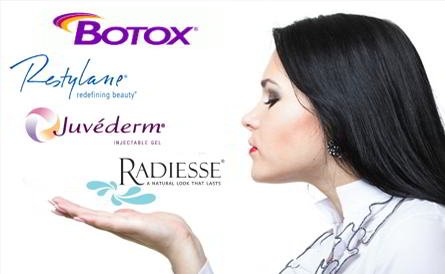There’s no truce, no surrender in the “War on Wrinkles”.
Unleash the power of high-performance botanicals, rare exotics, and age defying nutrients to smooth and nourish your skin... before your surgeon makes a single jab or incision.
Yes, I want my face to look young again

Dermal Fillers and
Anti-Wrinkle Neurotoxins
Patients not wishing to undergo invasive surgical corrections of age-related facial imperfections, have at their disposal several highly effective injection treatments. They fall into two broad categories. First are the neurotoxins such as Botox®, which are used primarily to relax wrinkles and soften lines.
The other popular option is fillers, such as Restylane®, which are used to strategically add volume for smoothing and contouring effects. Using both technologies, patient satisfaction is generally quite high as they often see dramatic improvement at relatively low cost.
Neurotoxins
For the neurotoxins, four products dominate the conversation: Botox®, Xeomin®, Dysport® and Jeuveau®. In application all behave more or less the same, and offer similar results. They all use variants of a botulinumtoxin to freeze muscle movement.The typical areas targeted for treatment are frown lines, lateral canthal lines (crows feet), and glabellar (forehead) lines. There can be as much as a 2-4 week delay before seeing results. Because the effects of the injections are not permanent, over the course of a year, multiple visits to the aesthetics practioner will we necessary.
Your cosmetic surgeon will recommend the best brand (type) based on your particular problem. For example, Dysport® has better tissue penetration and can cover a wider treatment area, while Xeomin® is suitable for patients who have developed tolerance to other variants.
Dermal Fillers
Volumizing Fillers is the other category of injectibles which has found widespread plastic surgery patient appeal. These fillers are further divided into hyaluronic acid based and non-hyaluronic based. The 4 most popular hyaluronic acid based are Juvéderm®, Revanesse®, Restylane® and Stylage®. In the non-hyaluronic sector one finds Sculptra®, Aquamid®, and Bellafill®. All fillers attempt to make corrections to correct imperfections by displacing volume and occupying facial space.A very popular use of injectible dermal fillers is to add lip volume. Age-related loss of lip volume as well as the appearance of vertical lines along the upper lip are sending millions of women to their surgeon or dermatologist for a corrective procedure. Besides smoothing any wrinkles and adding volume to the tubercle areas, the surgeon will also consider improvements to the shape of the “cupid’s bow”.
Another problem area where older patients seek relief is the nasolabial folds the extend from nose to mouth. A visible sign of age, these lines are particularly well suited for a dermal filler solution. Cheeks are also good candidates for fillers because by injecting above the cheekbone a more youthful facial definition can be achieved.
There are some important downsides to fillers of which patients and their physicians must be aware. Since the goal is to create a natural, more youthful appearance without looking medically modified, extra care must be taken to avoid overfilling the targeted areas. Fillers are stretching a patient’s face. There is a fine line between effects which smooth and contour, and overuse, which can create unsightly puffiness. Taken to an extreme it can result in unnatural distortions, even the so-called “alien face” effect, which occupies so much media attention.